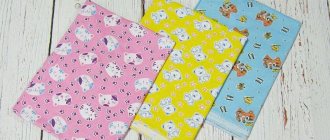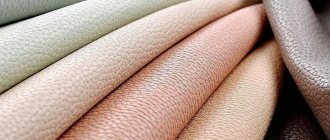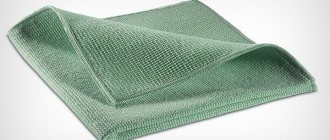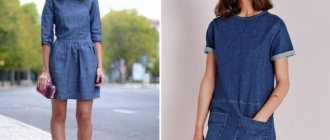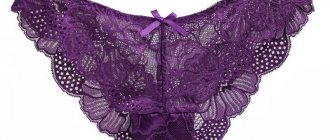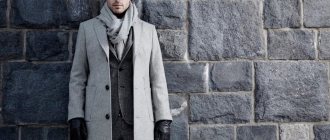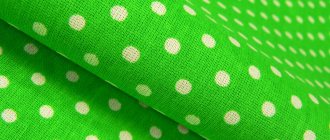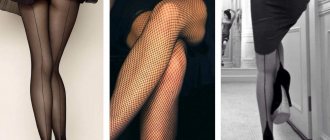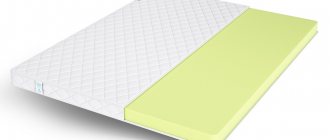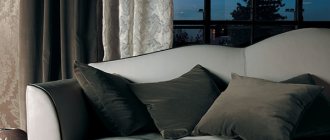Everywhere there is only talk about the heat at +40 °C, that it is impossible to be outside, that you simply can’t breathe, that the store is out of ice cream... But life is life. We have to leave the house in this scorching heat. In order to somehow make life easier, I want to quickly change into open, light clothes. Let’s talk further about what fabric to make dresses from to make summer warmth a joy.
Natural fabrics for summer dresses
Natural materials are good because they “breathe” - they allow air to pass through well, and the body feels comfortable in such clothes. They absorb moisture well and have excellent thermal insulation qualities - they are not hot in summer and not cold in winter.
Such materials are expensive, things made of natural silk and linen are especially valued.
But natural materials also have disadvantages:
- they wrinkle easily and lose shape when worn;
- some materials are highly hygroscopic and take a long time to dry;
- they lose color easily and fade when washed;
- Pellets may appear on the surface.
Let's consider natural fabrics for the summer that are most suitable for sewing dresses.
Material care
Any fabric requires care, otherwise it will quickly lose its neat appearance.
Cotton is easy to care for. It can be washed in water of any temperature, depending on the degree of contamination. White dresses can be washed with a small amount of bleach.
When washing, you should follow the rule of sorting clothes by color. For example, it is not recommended to wash white and red; dyed materials may fade.
Do not dry delicate items made of cotton or any other natural material in the machine - the centrifuge may damage them. It is better to dry it flat or on a hanger - this way it will wrinkle less.
There is no need to twist the products too much when manually squeezing.
Clothing manufacturers recommend washing viscose on a delicate cycle and not using aggressive detergents.
Silk needs care. It is advisable to wash such dresses by hand, but not in hot, but in lukewarm water. When washing, do not rub the item too much. And press with your hands without twisting. In this case, you can wrap the item in a dry towel so that excess moisture is absorbed into it.
Caring for clothes made of silk fabric.
In fact, it is better to entrust the care of silk to a dry cleaner, where the expensive item will be taken care of professionally. If not properly cared for, a chic silk dress can quickly become unusable. Detergents should be chosen for delicate items. Iron with a slightly warm iron. The product must be dry, as the slightest drops of water can form streaks.
Synthetic fabrics should be washed at a temperature of 30-40º, otherwise they may shrink. Drying flat will help avoid wrinkles on clothes. Even if the item is wrinkled after washing and drying, ironing at temperatures up to 200º will correct the situation.
Before purchasing, pay attention to the care instructions. This way you can make the right choice.
Cotton fabrics
This group includes chintz, calico, staple, denim, flannel, satin, cambric. Denim is a thick cotton fabric with a characteristic weave, dyed blue on one side. A lightweight version of denim is jeans. As a fabric for summer, denim is too thick, although a stylish dress can be made for not too hot weather.
Calico, chintz and cambric are lightweight fabrics for the summer, but now they are rarely used for sewing dresses, as they wrinkle easily and quickly lose their attractiveness from frequent washing.
An excellent material for a dress is staple. A practical and beautiful staple today is widely used by designers. Modern staple has a mixed composition and is a combination of cotton and lavsan (or viscose). The material is light, pleasant to the touch, quite dense and practical, and drapes well. If you are thinking about what material to make a summer dress from, staples are ideal for this purpose.
Silk
Delicate flowing silk is the best fabric for summer, especially hot summer. Both artificial and natural silk are very pleasant to the touch, almost imperceptible on the body. Natural silk is very expensive, but modern artificial analogues are practically not inferior to it in quality.
Silk is an ideal fabric for a summer sundress, a dress with a wide skirt of any length, a wrap dress or a Chinese-style outfit (in this case, you need to choose the appropriate pattern).
Linen
Linen looks very stylish, it is not hot even at very high temperatures, but it wrinkles easily and strongly, this is the main disadvantage of linen. This is a suitable fabric for a floor-length summer dress with a straight silhouette. Undyed linen is often decorated with borders, embroidery, and ornaments at the neckline and at the bottom of the garment and looks very elegant and attractive.
Rami
Chinese nettle fibers are used to make ramie. The plant has been used for the production of textile fibers for a long time. Externally, ramie resembles linen, is easy to dye and wrinkles easily. The material is durable and can withstand high temperatures. Ramie and linen are breathable summer fabrics that absorb moisture well. Ramie makes an excellent dress with an a-line silhouette or straight-cut clothing.
Hemp fabric
Another material of natural origin, pleasant to wear. Hemp fabric is hypoallergenic, absorbs moisture well, does not shrink when washed, and dyes well. Hemp clothing almost completely blocks the effects of ultraviolet radiation, protecting the skin. Hemp material can be either rough, almost like burlap, or soft and smooth. This is an excellent fabric for a summer skirt, dress, sundress.
Wool
Summer is not always hot, so a dress made of fine wool can be useful in cool weather. Models with short sleeves and three-quarter sleeves never go out of fashion. Both a tight-fitting dress and an option with a wide skirt made of fine wool look great.
If you work in an office where air conditioning keeps things cool, the stylish six-piece model will be the most suitable option.
Muslin
Muslin is a very thin material that is obtained from 100% natural raw materials. Most often made from cotton, wool, and silk fibers. The most common type is cotton muslin.
In clothing made from fabric that has an “organic” certificate, it is implied that at all stages of its production (growing and harvesting cotton, preparation, processing, the actual production process) only environmentally friendly, safe, and ethical methods were used.
Summer dresses made from material obtained in this way are not hot, the skin “breathes”, the fabric is soft and delicate, and protects from ultraviolet radiation. Products made from muslin are easily recycled without harming the environment.
Blended fabrics
They are a combination of synthetic and natural fibers. Typically, the blended material contains cotton and synthetic fibers, which give it strength, durability and elasticity. Blended fabrics are the best fabrics for clothing, combining the advantages of synthetics and natural fiber. They do not fade under the bright sun, do not shrink, are well ventilated, do not wrinkle, and keep their shape perfectly.
Clothes are easy to care for and retain their impeccable appearance for a long time.
Mixed fabrics for summer clothing are always available in a wide range of stores. Since the canvases are easy to paint, they are decorated with complex and colorful designs and prints. The price for these materials is affordable. In addition, this is a summer fabric that does not wrinkle - ideal for sewing casual clothes.
Cotton
The most common of natural fabrics. The material is soft, pleasant, absorbs moisture well, and dries quickly. Other positive qualities of cotton:
- does not cause allergies or skin irritation;
- It’s easy to care for cotton products;
- tolerates a large number of washes, wear-resistant;
It is important that the quality of the fibers is influenced by growing conditions and the type of cotton. The highest quality grows in India and Egypt. Long cotton fibers are used to make a fine, high-quality fabric that can be worn in the heat of summer. But many manufacturers use cheap raw materials, items from which quickly lose their shape and become covered in pellets.
When making fabric, other fibers are often added to cotton. Two to five percent elastane, for example, makes the material elastic and resilient. This is a good combination for those who like to wear tight-fitting clothes in summer.
It is important to pay attention to the product label. Too large a percentage of artificial additives will negate the positive qualities of cotton.
The fact that cotton fabrics worn in summer wrinkle easily is a disadvantage. Cotton items need to be folded carefully, then they will look much better. Inexpensive materials can shrink and become deformed.
This natural material is great for those who are still wondering what fabrics to wear in the summer. Almost any summer clothing is made from cotton - skirts, jackets, T-shirts, shorts. It is recommended to wash plain colored items at 60 degrees, thin multi-colored items at 40. Dry, straighten, iron slightly damp.
Artificial fabrics for summer
Such types of summer fabrics as viscose and modal are artificial.
Viscose
Viscose cannot be 100% classified as an artificial fabric, since it is a natural fiber obtained artificially. The basis of the material is cellulose obtained from wood. The pulp is formed into fibers that are dried, pressed, bleached and dyed. Viscose production technologies vary, so the material can resemble silk, wool or linen.
If you are wondering what fabric to make a summer dress from, viscose is a great choice in summer. It is very pleasant to wear - soft and silky to the touch, drapes effectively, forming soft folds. May contain natural or synthetic additives that make the material stronger or more elastic.
Modal
This is a type of new generation viscose. Modal is also made from cellulose and is an environmentally friendly material; it contains no harmful impurities. Modal has all the advantages of natural fabric - it is hygroscopic, perfectly breathable, durable and very comfortable to wear. This is a wonderful material for a summer dress, skirt, sundress.
Linen
The material is considered “cold” and retains coolness for a long time. Linen allows the skin to breathe, making it suitable for the summer heat. The main positive qualities of the fabric:
- Environmentally friendly. Waste from the production of linen is used in the production of furniture as fuel.
- Stays clean longer than other materials. Linen fabric needs to be washed less often. This simplifies the care of clothes and increases their service life.
- Does not lose shape, very durable. The wear resistance of cotton is two times greater than that of wool, and that of wool is four times greater.
- Colored items will not fade in the sun.
- If the fabric has not been dyed, it retains bactericidal properties.
A well-known disadvantage of linen clothes is that they wrinkle a lot. But given the positive qualities of linen, this drawback can be ignored. When buying linen items, it is worth considering that they will not stretch. Pants that are slightly too small will remain that way; wearing them in the summer will be problematic.
Pants, shirts, and sundresses are made from linen fabric. You can also wear bags, hats and even shoes in summer. Undyed fabric can be washed at temperatures up to 90 degrees. Colored ones will withstand no more than 40. It is better to dry things straightened out, iron them damp or in the steam mode.
This is interesting: Duspo fabric: description, characteristics, application
Summer clothes: what to wear
- The dress is a universal outfit for any occasion that goes well with any accessories: handbag, hat, jewelry, shoes, sunglasses.
- Sundress - emphasizes femininity; with the help of a sundress it is easy to create a wonderful romantic image. Breathable fabrics for the summer are ideal for a sundress - all natural and mixed materials, artificial and natural silk.
- A skirt is a comfortable part of a summer wardrobe. Any summer fabric that does not wrinkle, or does not wrinkle too much, is suitable for sewing a skirt. These are modal, viscose, mixed materials.
A summer suit is also a great choice. This outfit can hide figure flaws and skillfully highlight advantages. For a suit with a tight-fitting silhouette, you should choose breathable fabrics - mixed and natural. Plain suits look more expressive and festive, ensembles made of colored fabrics are more suitable as everyday wear.
Selection by color type
The most common color type is Summer.
Youth summer dress
Peculiarities:
- Tenderness, thinness of the skin, its coolness;
- Redness and capillaries, gray-brown freckles;
- Pinkishness and uneven blush;
- Tanning speed;
- Light brown, ash dark brown hair color;
- Hair burning under the sun's rays;
- Early gray hair;
- Dimness and cloudiness of the eyes - blue, gray-blue, blue tint;
- Light brown eyebrow color.
Choosing a wardrobe.
- Romantic style of clothing. Outfits with frills, ruffles and other decorative elements are perfect;
- The color of the wardrobe is blue. The best option for choosing clothing colors is smoky blue, denim blue, blue-gray, soft blue and other shades of color;
- Purple, dark pink and red colors will take their rightful place in the wardrobe;
- Natural white will not work. Preference should be given to color variations - “eggshell”, “bleached oak” and other shades;
- Brown clothes with a gray undertone;
- The choice of light shades for sundresses, shirts - mint, soft pink, violet, cream palette.
Straw
pros
+ Straw is a lightweight, breathable and well-blown material.
+ A big plus is that the straw material provides good UV protection.
+ Straw is a natural and ecological material.
+ Straw is an affordable material.
Minuses
— Straw is a fairly fragile material, so if it is poorly woven, it can tear quite quickly.
— This material does not tolerate moisture and can be deformed under its influence.
— The straw may turn yellow over time.
Method of caring for straw products
Straw products must be cleaned of dust after wearing. To do this, you can use a soft damp brush or a well-wrung out sponge. Straw products recover their shape well from steam if they suddenly become deformed. Try to avoid exposure to large quantities of water, as this will cause the straw to swell and the product may become permanently deformed. A little secret: before I send the straw product to “winter,” I thoroughly clean it with a solution of lemon juice in a ratio of 1:4. This helps prevent yellowing and keeps the item in good condition.
My choice
I'm a straw hat fan. This is a wonderful and at the same time useful accessory: it protects from the sun, prevents your head from overheating and at the same time looks very stylish. On vacation or in nature, you can wear wide-brimmed straw hats; for the city, I prefer a boater hat with a small brim. A straw hat is a classic and stylish accessory that will perfectly complement your flying look. I also recommend a straw bag. Today you can find many different models, suitable for both work and leisure. Even famous fashion houses make handbags from straw, so there is something for everyone. Personally, I prefer the classic basket bag. It is light and summer elegant. This bag will go well with jeans or shorts with a white or blue shirt (in the style of Jane Birkin), or with a flowy linen or cotton dress. You can take it for walks, picnics, shopping and to the beach. I also love straw shoes - sandals, flip-flops and espadrilles. On a hot day this is the best choice. But it is worth remembering that if you get caught in the rain wearing such shoes, they can become completely unusable.
What do you think of these materials? Which one is your favorite?
Part 2 - silk, lyocell and modal
Share:
Purpose of acquisition
Every woman wants to have a new dress for summer. Fashion magazines begin to publish photographs and patterns of outfits for the summer season in the spring. Even an unprofessional dressmaker can easily sew an ordinary dress, following the detailed instructions that accompany the models presented in them.
Before you go to the store, you need to decide what kind of dress you plan to sew - for work or for leisure. Where is it supposed to be worn - to the office or to the beach. The second important task is to determine how much fabric is needed for the selected model, taking into account its shrinkage after washing. Many people forget about this and try to get an answer from the seller. As a result, they buy either less fabric than needed or more.
Viscose
Viscose is a natural chemical fiber. Not to be confused with synthetics! Viscose is made from wood that is crushed, fermented and combined with an adhesive. The result is a fabric resembling cotton. Viscose is used to make excellent lightweight fabrics for summer dresses. They are distinguished by the richness of their colors, flowing like silk and soft like cotton. Chiffon dresses made from natural viscose are very good for summer. They are almost impossible to distinguish from silk ones.
Viscose is prone to shrinkage, so like cotton, it needs to be wet and dried before cutting.
Viscose fabrics for summer dresses wrinkle quite a lot and lose strength when wet.
Chintz
Thin cotton material that is not hot. Positive qualities of chintz that allow you to wear it in the summer:
- environmental friendliness - no artificial additives are added to the composition;
- durability of the pattern - does not lose its brightness after numerous washes;
- affordable price;
- does not cause skin reactions or allergies;
- breathability, hygroscopicity.
The disadvantages include fragility - chintz products last on average two seasons. A poorly applied drawing may fade. Exposure to high temperatures is unacceptable. Calico fabric shrinks and wrinkles easily.
Thick chintz is used for sewing dresses, light blouses, and tops that women and girls enjoy wearing in the summer. They wash and iron such clothes, just like cotton ones.
Other options
In choosing a summer dress, in addition to the composition of the fabric, its density and color are also of great importance, which are chosen depending on the style, characteristics of the figure and the purpose of the outfit.
Density and texture
- Thus, beautiful thin translucent summer fabrics are chosen for voluminous dresses with draperies, which look beautiful on a thin figure and will be appropriate at parties, romantic dates or just any special event.
- Thicker, opaque fabrics are perfect for models with a clear silhouette; they will also help hide some features of the figure. These dresses are suitable for work.
- Outfits made from shiny fabrics should be chosen with caution - they tend to increase the volume of the body, especially if the silhouette is tight-fitting. Satin and silk summer dresses will look appropriate in the evening.
- Lace dresses are perfect for hot weather; they look attractive and elegant.
Colors
Summer dresses made of plain fabric will be appropriate in any situation; those made from coupon fabric look original and attract attention to the clothes and figure. Therefore, for overweight women, patterns that are too bright and large, as well as stretch that is too tight to the figure, are not recommended.
summer dress made of fabric called “Chill”
Chiffon
Airy chiffon sundresses and skirts are great for wearing in the summer. Translucent, breathable material will save you from overheating in hot weather. It is better that it is made from natural raw materials - silk, cotton. Advantages of chiffon:
- strength, tear resistance;
- easy to drape;
- pleasant to the touch;
- quickly absorbs moisture and dries;
- does not cause allergies, prevents the growth of bacteria.
In summer they wear chiffon pareos, dresses, and skirts. The material is quite difficult to care for. It should be washed by hand, using soft detergents, at a temperature of 30 degrees. Spin cannot be used. Iron chiffon at low temperature from the inside out.
